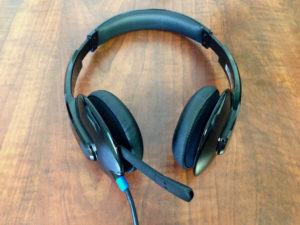
As an Instructional Designer, part of my job is to help our faculty learn how to construct various components of a Blended or Online course. Typically, this means they need to learn how to create their own instructional videos using a screen-recording program like Camtasia. We offer several bits of advice when starting this process for the first time, such as ‘the instructor should appear in the video’ and ‘limit your recording to 10-15 minutes’, but one of the most important pieces of advice that we give is to use equipment that will ensure a high-quality video. This includes high-quality audio, because there is nothing that will ruin a video faster than poor audio.
We’ve all come across these videos – there are probably tens of thousands of them on YouTube. They’re the ones where you hit the Play button and the video starts but you don’t hear anything. So you turn up the volume on the video, then the volume on your computer, then maybe on your speakers too (if you have external speakers), and now you can hear what the person is saying but there’s also a lot of white noise, which is distracting. Of course later on, after you’ve forgotten that you cranked your volume all the way up, you’ll scare the daylights out of everyone in a 20 foot radius when you go to play something else that was recorded properly and it comes blasting out of your speakers. It happens to the best of us.
What can you do to ensure that you’re recording high-quality audio?
Find a quiet area to make your recording
In a higher education setting, this is sometimes easier said than done. Your typical faculty office has a lot of background noise: loud air-handling systems, ringing telephones, conversations in the hall, students knocking on doors, computer chimes from incoming emails, etc. Find a place in your building or somewhere on campus where these noises and disruptions don’t exist. These sounds will distract your students when they watch your video just like they distract you.
Use a USB or Bluetooth headset

The microphones built into most computers record low-quality audio and pick up a lot of background noise. The microphones on headsets can help to reduce a lot of the background noise, plus the arm keeps the microphone at a constant distance from your mouth, which allows you to maintain a consistent volume level throughout the entire recording.
You can find a good headset for around $30-$40 from companies like Logitech, Sennheiser, and Koss.
Take advantage of a recording booth
Many universities have recording booths dedicated for tasks like these with all of the equipment you need. They’re usually found in a library, media center, or teaching and learning center, and were probably setup by staff with AV and technical expertise. WCU has a recording booth in the Office of Distance Education available for faculty use.
Note: this article has been cross-posted in the West Chester University Office of Distance Education blog.
Comments (0)